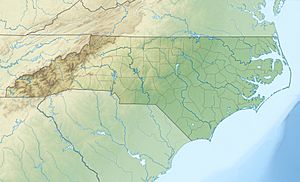Rocky Branch (Reedy Fork tributary) facts for kids
Quick facts for kids Rocky Branch |
|
|---|---|
|
Location of Rocky Branch mouth
|
|
| Other name(s) | Tributary to Reedy Fork |
| Country | United States |
| State | North Carolina |
| County | Guilford |
| Physical characteristics | |
| Main source | divide between Rocky Branch and Candy Creek about 1 mile east of Monticello, North Carolina 805 ft (245 m) 36°12′56″N 079°39′14″W / 36.21556°N 79.65389°W |
| River mouth | Reedy Fork about 4 southeast of Monticello, North Carolina 650 ft (200 m) 36°10′48″N 079°38′55″W / 36.18000°N 79.64861°W |
| Length | 2.49 mi (4.01 km) |
| Basin features | |
| Progression | south |
| River system | Haw River |
| Basin size | 2.32 square miles (6.0 km2) |
| Tributaries |
|
| Bridges | Turner Smith Road |
Rocky Branch is a small stream, about 2.49 mi (4.01 km) long, located in Guilford County, North Carolina. It is a "first order" tributary, which means it's a stream that doesn't have any smaller streams flowing into it. Rocky Branch flows into a larger stream called Reedy Fork.
Where Does Rocky Branch Flow?
Rocky Branch begins in Guilford County. Its source is near a natural divide, or high ground, that separates it from another stream called Candy Creek. This starting point is about 1 mile southeast of a town called Monticello, North Carolina.
From there, Rocky Branch flows generally towards the south. It travels for a few miles before it reaches its end. The stream then joins Reedy Fork. This meeting point is about 4 miles southeast of Monticello.
Understanding the Watershed
Every stream and river is part of a larger area called a watershed. A watershed is like a big bowl. All the rain and snow that falls within this area drains into the same stream, river, or lake.
The Rocky Branch watershed covers an area of about 2.32 square miles (6.0 km2). This means that all the water that falls on these 2.32 square miles will eventually flow into Rocky Branch. On average, this area gets about 46.0 inches of rain each year.
A big part of the Rocky Branch watershed is covered by forests. About 51% of the land in this watershed is forested. These forests are important because they help keep the water clean. Trees and plants slow down rainwater, which helps prevent erosion and filters out pollutants before they reach the stream.



